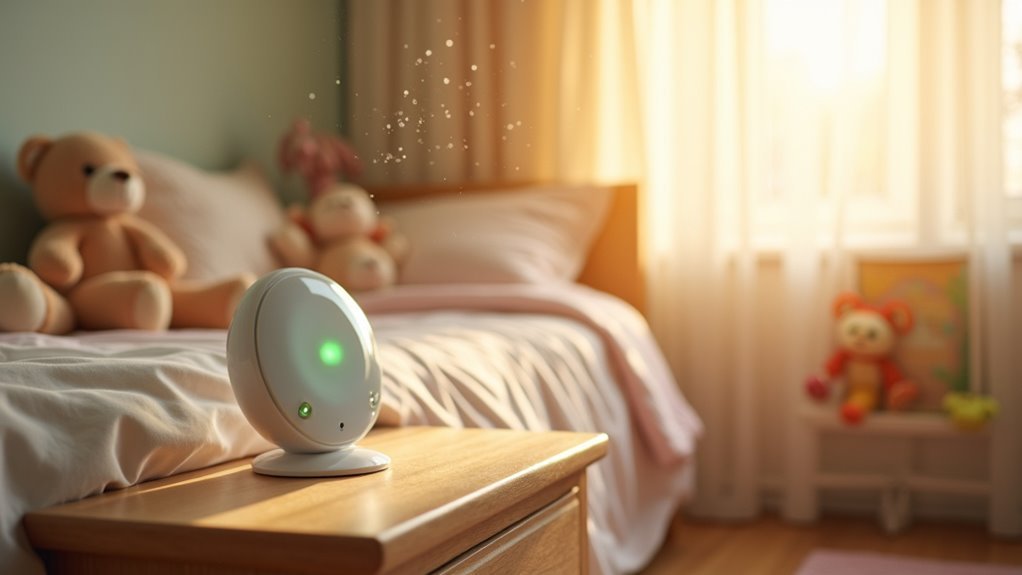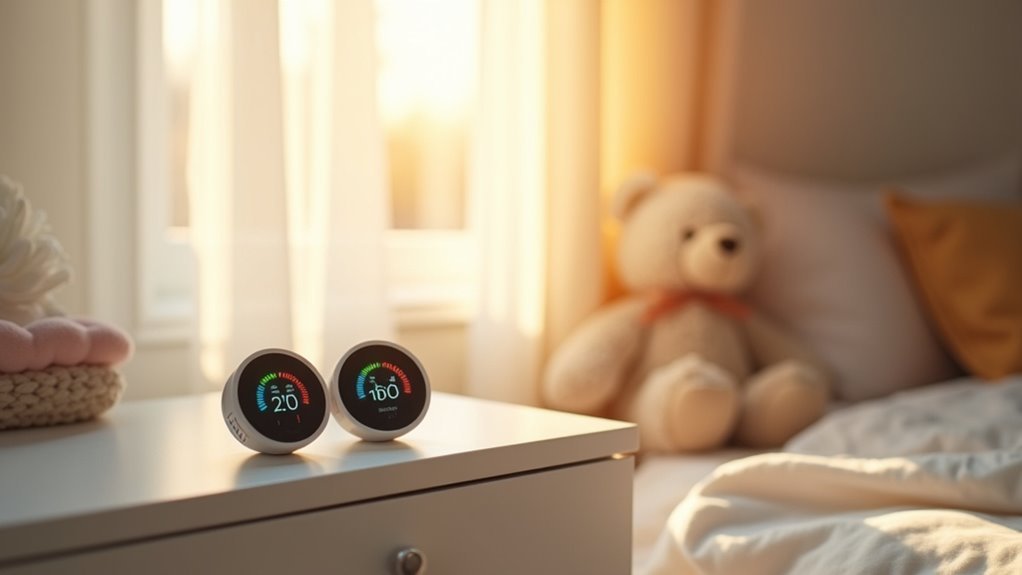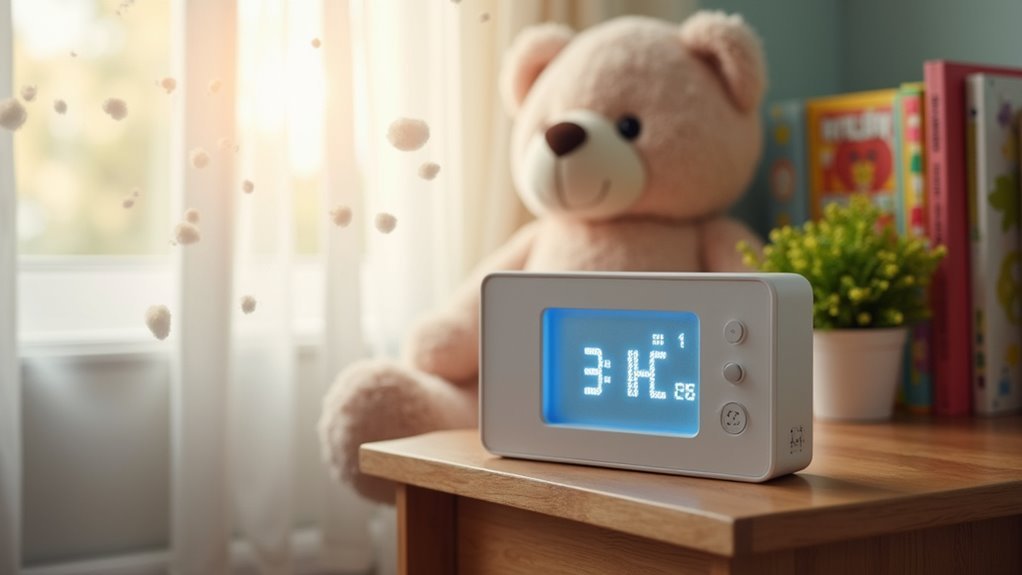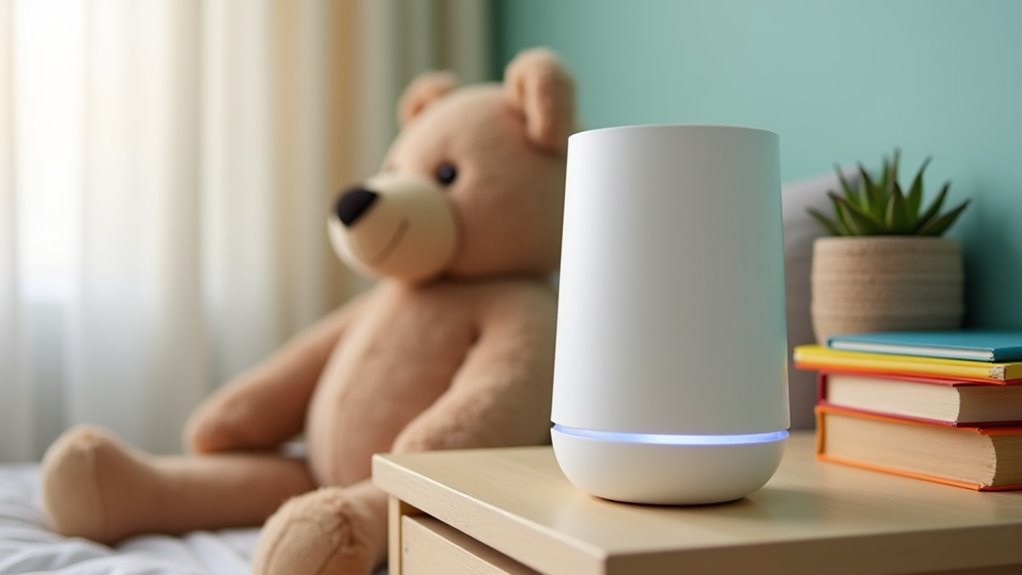You’ve probably never considered how many invisible threats are floating through your child’s bedroom air right now. While you’re focused on childproofing outlets and securing furniture, harmful pollutants like PM2.5 particles, volatile organic compounds, and elevated CO2 levels could be silently affecting your little one’s sleep quality, respiratory health, and cognitive development. The question isn’t whether you need an air quality monitor—it’s which features will actually protect your family.
Why Indoor Air Quality Matters for Children’s Health

Although you might assume your home’s air is clean, indoor environments can harbor pollutants that pose serious risks to your child’s developing respiratory system. The EPA reveals indoor air can be 2 to 5 times more polluted than outdoor air, making children’s bedrooms potential health hazards.
Your child’s developing lungs make them particularly vulnerable to pollutants that trigger asthma, allergies, and respiratory infections. Exposure to high PM2.5 levels can cause long-term cognitive deficits, directly impacting academic performance.
Children’s vulnerable respiratory systems face heightened risks from indoor pollutants that can trigger lasting health problems and impair cognitive development.
VOCs from household products lead to headaches, dizziness, and chronic health issues. Poor indoor air quality creates respiratory problems that follow children into adulthood.
Air quality monitors provide essential real-time data, helping you identify pollutants before they compromise your child’s health and development.
Common Air Pollutants Found in Kids’ Bedrooms
Your child’s bedroom harbors invisible threats that can impact their health and development.
Chemical sources like paints, furniture, and cleaning products release harmful VOCs into the air, while particulate matter from dust, pet dander, and outdoor pollution creates respiratory risks.
You’ll need to understand these pollutants to protect your child’s breathing space and guarantee they’re sleeping in clean, safe air.
Indoor Chemical Sources
When children spend up to 90% of their time indoors, the air they breathe in their bedrooms becomes critical to their health and development.
You’ll find numerous chemical sources releasing harmful substances into your child’s space. Paints, furniture, and cleaning products emit volatile organic compounds that can damage respiratory health and impair cognitive function.
Your child’s wooden furniture made from pressed wood or particle board releases formaldehyde, a dangerous carcinogen. Air fresheners and scented candles introduce phthalates that disrupt hormones and cause breathing problems.
High humidity creates perfect conditions for dust mites and mold, triggering asthma and allergies. An indoor air quality monitor helps you detect these air pollution sources before they impact your child’s health.
Particulate Matter Dangers
Beyond chemical emissions, microscopic particles floating through your child’s bedroom air present an equally serious threat to their developing lungs.
Particulate matter penetrates deep into respiratory systems, causing respiratory issues and reduced lung function. PM2.5 poses the greatest danger due to its tiny size, easily bypassing natural defenses.
Your child’s bedroom harbors multiple particulate sources: dust accumulation, pet dander, mold spores, and cooking smoke that drifts throughout your home.
These particles create serious health risks, particularly for children with developing respiratory systems.
Research directly links elevated PM2.5 exposure to increased asthma rates and worsened allergies in children.
While WHO recommends keeping PM2.5 below 10 µg/m³, most indoor spaces exceed this safety threshold.
Regular monitoring helps you identify pollution sources and create healthier sleeping environments for your children.
Essential Sensors Every Child’s Room Monitor Should Have

When choosing an air quality monitor for your child’s bedroom, you’ll need specific sensors that track the pollutants most harmful to developing bodies.
Core health sensors form the foundation of effective monitoring, measuring basic but critical factors like particulate matter, carbon dioxide, and humidity levels.
Advanced safety features take protection further by detecting volatile organic compounds and providing real-time alerts when air quality drops to dangerous levels.
Core Health Sensors
Your child’s breathing depends on having the right sensors monitoring their bedroom air around the clock.
PM2.5 Particulate sensors detect fine particles that penetrate deep into young lungs, causing respiratory issues in sensitive children. You’ll need CO2 levels tracked continuously since elevated concentrations impair cognitive function and disrupt sleep quality.
VOCs sensors identify harmful chemicals from furniture, cleaning products, and building materials that children’s developing systems can’t handle effectively.
Temperature sensors maintain comfortable sleeping conditions, preventing overheating or chilling that disrupts rest.
Humidity monitoring prevents both dry air that irritates airways and excessive moisture that breeds mold and bacteria.
These core sensors work together protecting your child’s health by alerting you to air quality problems before they impact breathing, learning, or sleep patterns.
Advanced Safety Features
While basic sensors provide fundamental protection, today’s most effective children’s air quality monitors include precision-engineered features that deliver hospital-grade accuracy for your child’s safety. These advanced systems combine multiple detection technologies to create thorough environmental monitoring that adapts to your child’s specific needs.
| Sensor Type | Accuracy Range | Critical Threshold | Health Impact |
|---|---|---|---|
| Particulate (PM2.5) | ±15 µg/m³ | >35 µg/m³ | Respiratory irritation |
| Carbon dioxide (CO2) | ±50 ppm | >1000 ppm | Cognitive impairment |
| Humidity sensors | ±3% RH | <30% or >50% | Mold/dry air issues |
| Temperature | ±0.1°C/F | <18°C or >22°C | Sleep disruption |
| Smart Integration | Real-time | Instant alerts | Automated responses |
Smart home integration enables automatic adjustments when readings exceed safe parameters, ensuring your child’s bedroom maintains ideal conditions around the clock.
Radon Detection in Children’s Sleeping Spaces
Every night, millions of children sleep in rooms where an invisible threat might be silently accumulating.
Every night, countless families remain unaware of the hidden danger lurking in their children’s bedrooms.
Radon, a colorless and odorless gas, poses serious health risks as the second leading cause of lung cancer. You’ll need specialized radon detection equipment to protect your children, as they’re particularly vulnerable to this harmful gas.
Installing radon detectors in children’s bedrooms provides real-time monitoring that’s essential for their safety.
Here’s what you should know:
- Test regularly – Radon levels of 4 pCi/L or higher require immediate mitigation
- Monitor continuously – Seasonal changes affect radon concentration
- Focus on sleeping areas – Children spend 8+ hours nightly in bedrooms
- Get professional help – EPA recommends testing homes with children
Don’t wait to protect your family’s health.
Monitoring PM2.5 and Particulate Matter Exposure

Beyond radon, another invisible threat circulates through your child’s breathing space every day. PM2.5 Particulate matter—microscopic particles measuring 2.5 micrometers or smaller—penetrates deep into developing lungs, triggering asthma and respiratory complications. You’ll need continuous monitoring to protect your child’s health and wellbeing.
| PM2.5 Source | Health Impact |
|---|---|
| Dust accumulation | Allergic reactions |
| Cooking smoke | Respiratory irritation |
| Outdoor pollution | Cardiovascular stress |
| Cleaning products | Airway inflammation |
| Pet dander | Asthma triggers |
Advanced monitors deliver real-time air quality readings, alerting you when particulate levels spike above EPA’s recommended 12 µg/m³ threshold. These devices identify pollution sources instantly, enabling immediate interventions like activating air purifiers or increasing ventilation. Continuous PM2.5 tracking transforms invisible threats into actionable data.
Carbon Dioxide Levels and Cognitive Development
You’ll find that elevated CO2 levels in your child’s bedroom can greatly impair their learning abilities, with concentrations above 1000 ppm reducing cognitive performance by up to 14%.
Poor air quality doesn’t just affect daytime focus—it also disrupts sleep quality, creating a cycle where your child struggles with both rest and mental clarity.
Maintaining ideal CO2 levels below 1000 ppm in bedrooms becomes essential for supporting healthy brain development and academic success.
CO2 Impact on Learning
When CO2 levels climb above 1,000 parts per million in your child’s learning environment, their brain doesn’t get the oxygen-rich air it needs for peak performance.
Research consistently shows that elevated carbon dioxide concentrations directly compromise cognitive function, creating barriers to your child’s academic success.
Here’s how high CO2 impacts your child’s learning:
- Reduced attention spans – Your child struggles to focus during homework or study sessions
- Impaired memory retention – Information doesn’t stick as effectively during critical learning periods
- Decreased academic performance – Test scores and classroom participation suffer measurably
- Long-term cognitive deficits – Extended exposure during developmental years creates lasting impacts
Monitoring air quality helps you maintain WHO-recommended levels below 1,000 ppm, protecting your child’s developing mind.
Sleep Quality Connection
While your child sleeps, elevated CO2 levels silently sabotage the restorative processes their developing brain desperately needs. When carbon dioxide (CO2) concentrations exceed 1000 ppm in your child’s bedroom, you’re setting the stage for restless nights and groggy mornings.
Poor air quality doesn’t just affect immediate comfort—it directly undermines sleep quality by disrupting natural sleep cycles. Your child’s brain requires ideal oxygen levels during sleep to consolidate memories, process learning, and support cognitive development.
High CO2 concentrations force their respiratory system to work harder, preventing deep, restorative sleep phases. This leads to decreased attention spans and impaired educational performance the following day.
Maintaining CO2 levels below 800 ppm creates an environment where your child’s sleep quality flourishes, supporting essential cognitive development during these formative years.
Optimal Bedroom Levels
Carbon dioxide concentrations in your child’s bedroom directly determine their cognitive potential, with levels above 1,000 ppm systematically eroding their ability to concentrate and learn effectively.
Creating an ideal environment requires maintaining CO2 below 600 ppm to guarantee peak cognitive performance and wellbeing.
Here’s what you need to know about maintaining healthy levels:
- Target Range: Keep CO2 levels below 600 ppm for ideal cognitive function and sleep quality.
- Warning Signs: Watch for headaches, fatigue, and impaired decision-making indicating elevated concentrations.
- Ventilation Strategy: Implement proper airflow systems to prevent CO2 buildup during sleep hours.
- Monitoring Tools: Use air quality monitoring devices to track real-time concentrations and maintain consistent healthy levels.
Consistent exposure to high CO2 levels negatively impacts your child’s long-term health outcomes, making bedroom air quality monitoring essential for their development.
Temperature and Humidity Control for Better Sleep
Since your child’s sleep quality directly impacts their cognitive development and overall health, creating the perfect bedroom environment through temperature and humidity control becomes essential.
You’ll want to maintain temperatures between 20-22°C (68-72°F) to prevent sleep disturbances and guarantee comfort throughout the night.
Smart air quality monitors provide real-time alerts when conditions shift, letting you make timely adjustments.
You should target ideal humidity levels between 40-60% to reduce allergens and dust mites, particularly important if your child has allergies or asthma.
Avoid levels above 60%, which promote mold growth and respiratory issues, or below 30%, which causes skin irritation.
Continuous monitoring helps you maintain this balanced environment, supporting better sleep quality and cognitive function while protecting your child’s health.
VOC Detection and Chemical Safety
Beyond temperature and humidity, you’ll need to monitor Volatile Organic Compounds (VOCs) that silently infiltrate your child’s bedroom from everyday household items.
These harmful chemicals emerge from paints, cleaners, and furniture, posing serious risks to your child’s respiratory health and cognitive development. Prolonged exposure can trigger allergies and breathing problems, making VOC detection essential for maintaining safe indoor air conditions.
Here’s how to protect your child:
- Install quality air quality monitors with dedicated VOC sensors for real-time alerts
- Allow 7-day calibration period for accurate long-term monitoring
- Increase ventilation regularly to reduce chemical concentrations
- Use HEPA-filter air purifiers to actively remove airborne contaminants
Effective monitoring helps you create healthier sleeping environments and respond quickly when indoor air conditions deteriorate.
Smart Home Integration and Remote Monitoring
While you’re monitoring VOCs in your child’s room, you can amplify protection by connecting air quality devices to your smart home ecosystem for seamless automation and remote oversight.
Smart home devices like Amazon Alexa and Google Assistant enable voice control of your air quality monitors, while IFTTT creates automated responses when pollutant levels spike.
Remote monitoring capabilities let you check real-time readings through mobile apps, receiving instant alerts about dangerous air quality changes even when you’re away.
Your system can automatically activate air purifiers or adjust HVAC settings when elevated pollutants are detected. Temperature and humidity sensors guarantee ideal room conditions for better sleep quality.
This integrated approach transforms passive monitoring into active protection, maintaining healthier indoor environments through intelligent automation.
Optimal Placement Strategies for Bedroom Monitors
You’ll maximize your air quality monitor’s effectiveness by carefully considering where and how you position it in your child’s bedroom.
The monitor’s height, distance from key areas, and proximity to air circulation sources directly impact measurement accuracy and your ability to detect potential health hazards.
You’ll also want to adjust display settings appropriately for nighttime use to avoid disrupting your child’s sleep while maintaining continuous monitoring capabilities.
Height and Distance Considerations
When positioning an air quality monitor in your child’s bedroom, the height at which you place the device directly impacts the accuracy of its readings.
You’ll want to take into account both elevation and distance from surrounding objects to guarantee ideal performance.
Here are key height and distance considerations:
- Install at 3-5 feet from the ground – This matches your child’s breathing zone and provides the most relevant air quality data for their daily activities.
- Maintain 1 meter clearance from walls – Distance from large furniture and walls prevents interference that could distort readings.
- Avoid floor-level placement – Ground positioning exposes monitors to drafts and inaccurate measurements.
- Keep away from heat sources – Distance from humidifiers and heating elements ensures accurate temperature readings.
Avoiding Air Circulation Interference
Since proper air circulation around your monitor directly affects measurement accuracy, you’ll need to strategically position the device away from sources that disrupt normal airflow patterns.
Place your air quality monitors at least three feet from walls and furniture to prevent interference with natural air circulation. This distance guarantees the device captures representative air samples rather than stagnant pockets near surfaces.
Avoid positioning monitors near vents, windows, or doors where drafts create fluctuating readings that don’t reflect your child’s actual breathing environment.
These locations expose sensors to outdoor influences and inconsistent airflow that compromises data reliability.
Keep devices away from heat-producing electronics and appliances, as these create localized air currents and electromagnetic interference.
Maintaining proper clearance around your monitor assures accurate readings of the air your child breathes.
Night Mode Display Settings
Air quality monitors with night mode features offer dimmed displays and reduced brightness levels that protect your child’s sleep while maintaining continuous monitoring capabilities.
These specialized display settings guarantee you’ll receive essential air quality information without creating disruptive glare or light pollution in your children’s bedroom environment.
To optimize night mode display settings for maximum effectiveness:
- Position monitors away from direct light sources to prevent reflections and enhance the dimmed display’s visibility during nighttime checks.
- Install at eye level but out of children’s reach for quick parental monitoring while maintaining safety protocols.
- Connect to smart home systems for automatic brightness adjustments based on room occupancy and time schedules.
- Ensure proper airflow around devices to maintain accurate sensor readings without compromising the night mode functionality.
Real-Time Alerts and Notification Systems
How quickly can you respond to dangerous air quality changes that could affect your child’s health? Real-time alerts from air quality monitors instantly notify you when harmful pollutants like CO2 or PM2.5 reach dangerous levels in your child’s bedroom.
Advanced monitors such as the Airthings View Plus offer customizable mobile app notifications, letting you set specific thresholds based on your child’s sensitivities.
These alerts integrate seamlessly with smart home systems, automatically triggering air purifiers or HVAC adjustments when pollutant levels exceed safe limits.
LED indicators provide quick visual assessments at a glance, perfect for monitoring your child’s room.
Consistent real-time monitoring helps you track air quality trends over time, enabling informed decisions about ventilation and air purification needs based on historical data patterns.
Calibration and Maintenance Requirements
While real-time alerts keep you informed of immediate air quality changes, maintaining your monitor’s accuracy requires consistent calibration and upkeep.
Proper maintenance guarantees your device provides reliable indoor air quality readings for your child’s bedroom.
Follow these essential maintenance steps:
- Initial Setup – Allow 7 days for VOC and CO2 sensors to complete their initial calibration period before relying on readings.
- Regular Recalibration – Follow manufacturer guidelines for periodic recalibration schedules, typically every few months depending on your specific model.
- Environmental Adjustments – Check calibration when temperature or humidity changes considerably, as these factors affect sensor performance.
- Built-in Reminders – Use your monitor’s calibration reminder features to stay on schedule and maintain ideal accuracy for sensitive measurements.
Budget-Friendly Vs Premium Monitoring Solutions
Understanding your budget constraints helps determine which air quality monitoring features matter most for your child’s health.
Budget-friendly air quality monitors like the GoveeLife Smart Air Quality Monitor offer essential PM2.5, temperature, and humidity tracking for around €299. These models provide basic protection but may have limited data storage and connectivity features.
Premium options such as the Airthings View Plus deliver extensive monitoring with seven sensors, including radon and VOC detection, also priced at €299.
You’ll get advanced app integration, real-time alerts, and superior accuracy after a seven-day calibration period. Premium models typically offer extended sensor lifespans up to seven years compared to budget alternatives, making them more cost-effective long-term investments for your child’s bedroom air quality monitoring needs.
Creating Action Plans Based on Air Quality Data
Once you’ve collected air quality data from your child’s bedroom monitor, you’ll need to transform those numbers into specific actions that protect their health.
Creating effective action plans based on air quality monitors guarantees you’re responding appropriately when conditions deteriorate.
Here’s how to develop actionable responses:
- Set Clear Thresholds – Establish PM2.5 limits below 12 µg/m³ and CO2 levels under 1,000 ppm as your trigger points for immediate intervention.
- Implement Immediate Responses – Open windows or activate ventilation when CO2 rises, and turn on air purifiers when PM2.5 spikes occur.
- Configure Smart Alerts – Program your monitor to send notifications when air quality deteriorates, enabling proactive adjustments to humidity and temperature.
- Track Long-term Patterns – Review monthly data trends to identify recurring issues and make permanent environmental improvements.
Frequently Asked Questions
How Do You Check Air Quality in a Bedroom?
You’ll need a thorough air quality monitor that tracks PM2.5, CO2, temperature, and humidity. Choose one with WiFi connectivity and app integration for real-time readings and alerts about hazardous conditions.
Do Air Quality Monitors Really Work?
Yes, air quality monitors really work. You’ll get accurate real-time data on pollutants like PM2.5 and VOCs. They’re proven to help reduce respiratory issues and improve health outcomes when you use them consistently.
How Do You Monitor Air Quality in a Room?
You’ll need air quality monitors that measure PM2.5, CO2, and VOCs with real-time data. Choose devices with smartphone apps for tracking trends and smart home compatibility for automated responses like activating purifiers.
What Are the Symptoms of Poor Air Quality in a House?
You’ll notice respiratory symptoms like coughing and wheezing, headaches from elevated CO2, allergic reactions including sneezing and runny nose, plus eye irritation and fatigue from chemical exposure in your home.





Leave a Reply